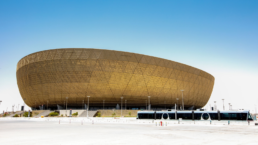A new report says stadium construction is largely to blame.
By Jessie Blaeser, Grist
The opening game of the 2022 FIFA World Cup is just days away, and all eyes are on host country Qatar, which has been getting ready to host the international soccer tournament since 2010. The preparations for the event, which organizers pledged would be “carbon-neutral,” have stirred up a significant amount of criticism related to worker exploitation and alleged human rights violations. Now, a climate watchdog group says the tournament’s organizers, which include representatives from FIFA and the Qatar government, misled the public by undercounting carbon emissions in one key area: stadiums.

Qatar has been on a decade-long World Cup construction boom, building seven new stadiums, 30 practice facilities, thousands of hotel rooms, and an expansion to the Doha International Airport.
Back when Qatar was awarded hosting privileges for the tournament, the event’s organizers pledged to offset all unavoidable emissions, largely through carbon credits. But achieving this “carbon-neutral” goal depends on a comprehensive accounting of all emissions associated with the World Cup, something researchers at the group Carbon Market Watch say FIFA and Qatar have failed to do.
“The main issue we found was with the construction of the stadiums,” said Gilles Dufrasne, policy officer for Carbon Market Watch and the author of the report, which was updated last month. He raised concerns about the placement of the stadiums and how they might be used in the future – two factors he says organizers did not sufficiently take into account in their carbon footprint calculations for this year’s tournament.
Already one of the hottest countries on Earth, Qatar faces worsening heat waves and water shortages as climate change intensifies. FIFA predicts activities related to this year’s World Cup will amount to 3.6 million metric tons of carbon dioxide, the equivalent of nearly 460,000 homes’ energy use for a year. According to FIFA’s latest emissions report, the largest sources of tournament-related emissions come down to air travel and accommodations, as more than 1.2 million fans are expected to attend the event from all over the world.
Stadium construction, meanwhile, accounts for roughly 18 percent of the group’s carbon estimations. In its report, tournament organizers calculated stadium emissions by splitting them between two different categories: temporary and permanent seats. Of the seven new stadiums built for the Qatar tournament, World Cup organizers plan to dismantle one entirely and reduce the capacity of the others by nearly half.
Recent Posts
Layoffs in 2025 Second-Highest Since 2009 in Potential Sign of Looming Recession
November 9, 2025
Take Action Now “Those laid off now are finding it harder to quickly secure new roles,” one of the report’s authors said.By Chris Walker,…
With Food Banks in ‘Disaster Response Mode,’ Supreme Court Lets Trump Pause SNAP Funds
November 8, 2025
Take Action Now This is insane,” said US Rep. Pramila Jayapal. “Trump is jumping through hoops to block SNAP.”By Jake Johnson, Common Dreams The…
How Many People Do You Have to Kill to Get a Peace Prize?
November 7, 2025
Take Action Now The Nobel Peace Prize is going to a Venezuelan advocate for deadly sanctions against — and an invasion of — Venezuela.By David…
New York’s Largest ICE Prison Dogged By Allegations Of Shoddy Medical Care
November 6, 2025
Take Action Now “I shouldn’t have lost my fingers,” one detainee said of ICE guards’ failure to get him the care a doctor prescribed.By J. Dale…




